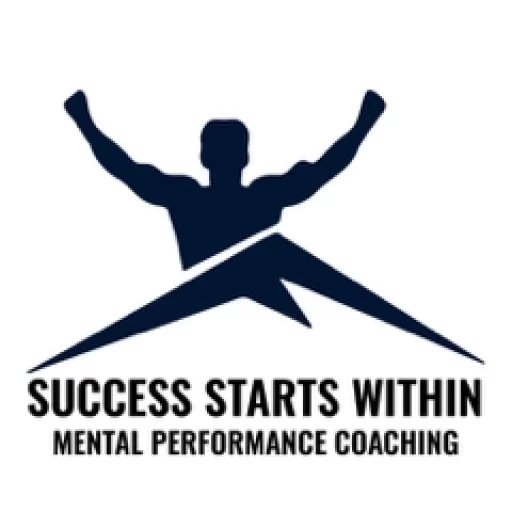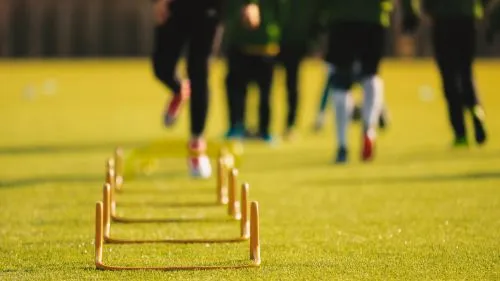Consistent. That’s a coveted title among athletes. Coaches want consistent players and players work to be consistent.
When you’re consistent, you’re reliable. Your coaches and teammates know they can trust you to go out there and give a good performance day in and day out.
But how do you become consistent?
It’s not by worrying about consistently getting good outcomes. In fact, that’s a major reason many athletes don’t play consistently well.
No, to be consistent as a player, you need to focus on actions you can control.
Actions you can be sure you’ll do if you have solid routines in place.
Using Routines to Create Consistency
As a mental performance coach, I work with a lot of athletes who are struggling with fear and anxiety.
They find themselves playing well in practice but not in games.
Fear and anxiety are the reasons why.
Playing with fear is typically centered around the fear of mistakes. Mistakes are seen as negative and should be avoided.
However, the goal of avoiding mistakes leads to timid play. And timid play is a major cause of underperforming.
Anxiety is closely related to fear. At times, it’s difficult to distinguish between the two.
Sports performance anxiety is characterized by extreme worries about what may or may not happen.
Once again, this worry mainly centers around mistakes. You worry about whether or not you’ll make a mistake, and what will happen if you do play poorly.
When we examine fear and anxiety closer, we see a common characteristic: focusing too much on the outcome.
Both are fueled by outcome thoughts. Thoughts about what may or may not happen.
These can include thoughts about the score, outcomes of plays or at bats, what coach will think of you, stats, and many others.
But why would a player focus on the outcome so much if doing so is known to drive fear and anxiety?
Because it’s the most natural way to think as an athlete. Especially if you’re focused on playing consistently.
The way consistent performances are determined is by the outcome. There’s no way around that.
However, that is for other people to worry about.
Not you.
If you, as the player, spend too much time thinking about the outcome and trying to play consistently, you’ll find yourself trying to force the game to go a certain way.
You can’t force good performances. They just happen.
How do they happen?
Through the actions you take. And that is what brings me to routines.
Routines Lead to Consistent Actions
There are two views of consistency. What I call a coach’s view of consistency and a player’s view of consistency.
Coaches are concerned with the outcome. That’s their job. But they’re also not the ones competing. Making it easier (and necessary) for them to focus on results.
You, on the other hand, are the player. You are the one competing. This means you need to be completely focused on what you’re doing. Which is impossible if you’re simultaneously thinking about the outcome and trying to force a consistent outcome.
Outcomes are the result of the process of your game.
Consistent outcomes are the result of a consistent process.
If you want to generate consistent outcomes, the real place you need to be focused is the process of your game.
That’s where routines come into play.
When you have routines in place, these generate consistent actions.
That’s the nature of routines. Doing the same thing over and over and over again.
Whether it’s consistency with training, your nutrition, mindset, or anything else, routines will help.
The Main Routines You Need as an Athlete
Remember, consistent performances come from consistent action. The process is what leads to the result you want, so you must be confident that the process you have in place is the best it can be.
Which is why, once again, you need to have routines you rely on within your game.
What I’ve done below is outlined the main routines you need as an athlete, to help you get started with becoming a more consistent player.
Routines Throughout the Week
These first three routines are the ongoing routines you want to have in place throughout the week.
While they may be altered from in season to out of season, these three are routines you should always be using.
The three routines you want to use throughout the week include: a daily physical training routine, a daily mental training routine, and a nutrition routine.
Daily Physical Training Routine
To be a high level player, you need high level skills. High level skills are developed through consistent work.
You can’t rely solely on team practices to get better. You need to be putting in work outside of team practice to fine tune certain aspects of your game.
While team practices are great, they are centered around the team. You may get some individualized attention, but not nearly as much as you’d get if you put in extra work throughout the week.
A daily physical training routine involves drills and exercises you do throughout the week to improve the weak areas of your game and build upon your strengths.
This routine will vary based on your sport and position. But the underlying principle of targeting specific areas of your game and continuing to fine tune the fundamentals always remains.
Daily Mental Training Routine
In addition to physical skills, high level athletes are strong mentally. To become strong mentally, just as with becoming strong physically, takes work.
A physical daily training routine is much more straightforward than a mental training routine. Because physical training is more tangible.
You know you are training when your heart rate increases and you begin to sweat.
While you may not sweat or have your heart rate increase with mental training, it is effective and crucial to your development as an athlete, nonetheless.
A daily mental training routine involves using sport psychology tools and techniques to train your mind.
Some example exercises include mindfulness meditation, a self-talk routine, and visualization.
These exercises work to increase confidence, strengthen focus, and give you more control over your thinking.
A strong mental game is the key to you unlocking your full potential as an athlete. And a strong mental game is built through a daily mental training routine.
Nutrition Routine
The third weekly routine you want to have in place is a nutrition routine.
Nutrition plays a key role in your energy levels and focus when you play. Not to mention the impact what you eat has on your mood.
Throughout the week, you want to have a nutrition plan in place. Don’t think of this like a diet. Think of this like a routine. Since that’s what it is.
It is a routine you follow to ensure your body and mind are getting the proper nutrition they need.
When your mind and body are fed optimally, you perform at your peak. When they’re not, you underperform.
One of the reasons I love a nutrition routine so much is because it makes getting the sufficient amount of nutrients you need easier. Instead of having to think through what you need to eat each day, you have a predetermined plan in place.
All you have to do is follow the plan.
Understand the number of macros you need for your goal, whether it’s to cut weight, build muscle, or anything else, and then craft your plan around those goals.
Put the plan in place, and you can trust your nutrition will be on point. Ensuring another element of being a consistent player is achieved.
Game-Focused Routines
Throughout the week, you want to have a physical training routine, a mental training routine, and a nutrition routine in place.
Now it’s time to shift our attention to games. The routines outlined below can also be used for practice, but are a necessity for games.
Pregame Routine
The first game-focused routine is a pregame routine.
What do you do right now leading into games? Are the actions you take targeted toward getting you into the best mindset to compete? Are they focused on priming your body to be fast and efficient?
A pregame routine helps with consistency because it allows you to repetitively generate the mindset you want going into games. It also makes sure your body is warmed up and ready to compete.
Without a pregame routine, you may find your mindset inconsistent. One day you feel great and the next not so great. That’s not an optimal strategy for consistent play.
By using a pregame routine, you give yourself the opportunity to start games in a consistent physical and mental state.
Here’s a video that walks you through a sample mental pregame routine you can use:
Pre shot/Pre At Bat Routines
Within games there are times when you need routines. These work in a similar way to a pregame routine, because they help increase confidence, focus, and composure.
A great example of a routine within a game is a pre at bat routine in baseball.
I have hitters create a routine they follow beginning in the dugout to get themselves confident, focused, and ready for their at bat.
I also use pre shot routines for golfers and basketball players at the free throw line.
The goal of these routines within games is consistency with approach.
No matter if it’s the very beginning of the game or a crunch time moment, you should approach each situation the same.
Your goal is always to do your best. So every moment needs to be approached with confidence and focus.
Plus, approaching situations in a consistent mindset and doing the same thing helps reduce pressure and stress in big moments. Since you’re approaching it just as you do every other similar situation within the game.
Post shot/Post At Bat Routines
In addition to pre shot, pre at bat, and any other pre routine you can use within the game based on your sport, you also need post routines.
An example of this is a hitter going through a quick post at bat routine after she struck out.
The goal of a post routine is to take any information you can (such as adjustments) from whatever you just did, and then move on quickly.
These routines help the most when you’ve made a mistake. But you want to use them all the time to instill them as habits.
Otherwise, when you are frustrated and need the routine, you likely won’t use it since the frustration makes it difficult to remember.
Post Game Routine
The last game-focused routine you need is a post game routine. This will be a combination of physical things you do (like recovery exercises) and a post game evaluation.
With recovery, that will vary based on your sport and position. But you want a post game routine in place to help your body start to recover and get ready for either the next game, practice, or training session.
A post game evaluation is a way for you to mentally process the game. With this evaluation you want to think of some good things about your game, along with some lessons you can take and things you need to work on.
A post game routine is a great way to wrap up the game and get yourself moving forward.
No matter if it was a good game or a bad game.
Final Thoughts
If your goal is to be a consistent player, instead of worrying about your stats and the outcome, focus on routines.
You want to be consistent with actions you take throughout the week. These actions increase your chances of getting consistent results.
During the week, you should have a daily physical training routine and a daily mental training routine. You also want a nutrition routine you follow.
For games, you need a pregame routine, a pre shot/pre at bat routine (depending on your sport), a post shot/post at bat routine, and a post game routine.
By creating your own routines and sticking with them, you will become the consistent player you want to be. Without the added stress and worry that comes with focusing too much on the outcome.
Thank you for reading and I wish you the best of success in all that you do.




